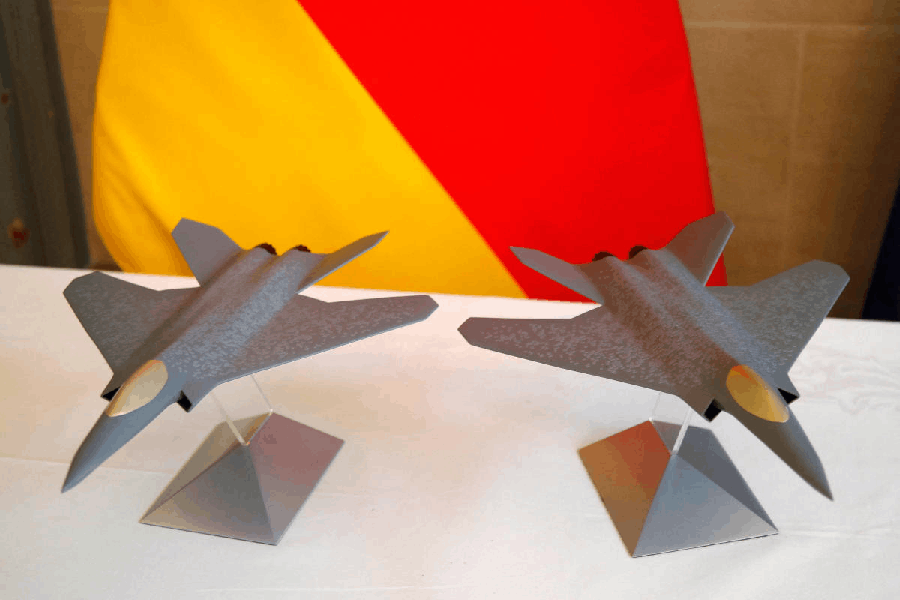 |
| Daksha Gowda has used bits of hand-woven Banarasi silk to design earrings and neckpieces |
 |
If gold, silver and platinum encrusted with precious and semi-precious stones give you a jewellery high, perhaps you haven’t felt the gentleness of cotton, silk and georgette ‘jewels’ brushing softly against your skin. Light as a feather fabric jewellery is stepping out of the shadows to make a bold and ‘heavy’ fashion statement.
A host of designers and brands have jumped onto the bandwagon and are creating jewellery made from bits of fabric that are embellished with embroidery or even stones. And just as you can customise real jewellery, designers are custom-making fabric jewels as well. Doing the rounds are neckpieces, earrings, bangles and even accessories like juda-pins.
Nitya Bajaj, who designs statement neckpieces for the Who’s Who of Bollywood, says that fabric jewellery has got the nod of approval from women of all ages. “It’s light, affordable, fuss-free and very attractive,” says Bajaj. She feels that this kind of jewellery is often more like a work of art and offers endless options in terms of colours and textures.
Bajaj says that fabrics like chiffon, georgette, tissue and organza work best for fabric jewellery because these can be easily ruched, gathered or pleated. She has developed a range of fabric neckpieces by giving different treatments like quilting, laser-cutting, pleating and surface- texturing these fabrics. Ruching and pleating is used to create three dimensional flowers in organza and tissue which are further embroidered and embellished with Swarovski crystals and beads. Luxe fabrics like lace, satin and velvet are used as accents for the neckpieces.
 |
| Malini Agarwalla’s raw silk creations are embellished with zardozi and kundan work |
The two hotsellers in her collection are neckpieces, The Victoria and The Emerald. The Victoria is out-and-out feminine and has flowers made of Lurex, pearls and crystals while The Emerald has an emerald, quilted satin base and is heavily embroidered. High on jewel tones, Bajaj’s collection makes an eye-catching statement in copper, green and champagne hues and is priced between Rs 4,000 and Rs 6,000. The neckpieces that use Swarovski crystals are more expensive and are priced between Rs 9,000 and Rs 15,000. Bajaj also customises the neckpieces according to the client’s pick of fabrics and stones.
Playing with humbler fabrics, Delhi-based designer Amber Paridhi Sahai of Mine of Design has used jute that’s been vegetable-dyed in peach, light green and brown to create neckpieces and earrings. “The best part about jute fabric is that it’s maintenance-free and light,” says Sahai.
She has set and even strung semi- precious stones like coral, onyx, Peruvian opal and chrysoprase on the jute. The line is priced between Rs 3,000 and Rs 15,000 depending on the handwork and quantity of the semi-precious stones.
 |
| People Tree’s jewellery line is fashioned from batik and screen-printed fabrics Pix: Rupinder Sharma |
Mumbai designer Malini Agarwalla’s pieces too stand out in the crowd. She loves to work with raw silk that’s worked with zardozi, kundan work, beadwork and semi-precious stones. “I’ve also used brocades and printed cotton fabrics to make fabric beads for the jewellery,” says Agarwalla. To create floral patterns, Agarwalla has used crochet, net and laces.
Her latest collection, Tribula, is inspired by the traditional Tibetan Gau boxes (or prayer boxes) and Thanka paintings. Reflecting Tibetan colours, Agarwalla has used lots of coral, amber and carnelian beads. “More recently we have used prints of old paintings of maharajas and maharanis and converted them into pop art,” she says.
 |
| Nitya Bajaj has used techniques like ruching, pleating, quilting and cut-work in her neckpieces; (below) Amber Paridhi Sahai’s line is all about semi-precious stones stitched on jute fabric Pix: Rupinder Sharma |
 |
| PixJagan negi |
Some designers are doing a double whammy with their collections. Besides designing out-of-the-box collections they are also generating employment for underprivileged artisans. Bangalore designer Daksha Gowda is using traditional Banarasi, hand-woven silk and empowering village women by teaching them jewellery-making with Banarasi silk.
Gowda and her team of rural women use pieces of leftover textiles to create earrings, bracelets and pendants. Priced between Rs 300 to Rs 350, the pieces are unique as each has been designed in a different fabric of a different colour.
Gurpreet Sidhu, the woman behind Delhi’s People Tree that’s well-known for its artwork, crafts, apparel and accessories, also works with less privileged craftspersons to create fabric jewellery. “We work with recycled materials,” says Sidhu. People Tree’s jewellery line uses waste fabrics that have been screen-printed or batik-dyed which impart the jewellery a distinctive look. She says that such jewellery uses low- cost production techniques and its rough, handmade look adds to its appeal.
It’s light on the skin, lighter on the pocket but is very heavy on the style quotient. So, perhaps it’s time to make a friendly switch from metal to fabric.











